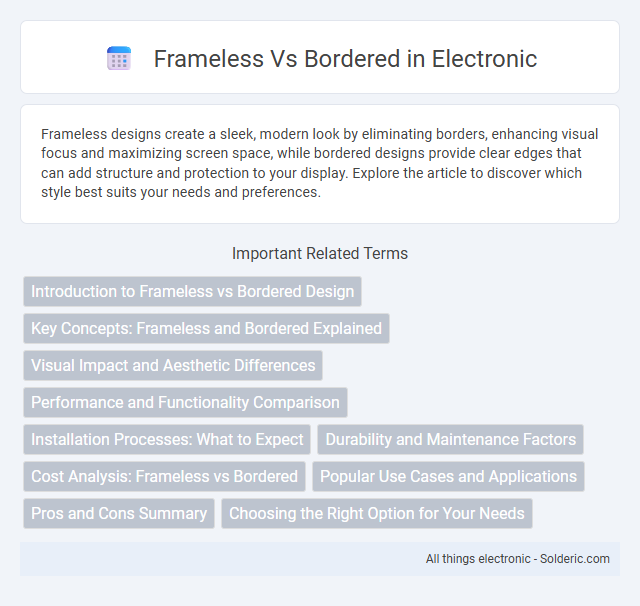Frameless designs create a sleek, modern look by eliminating borders, enhancing visual focus and maximizing screen space, while bordered designs provide clear edges that can add structure and protection to your display. Explore the article to discover which style best suits your needs and preferences.
Comparison Table
| Feature | Frameless | Bordered |
|---|---|---|
| Design | Minimalistic, modern look without visible edges | Classic look with defined edges and structure |
| Visibility | Edges blend with surroundings, less noticeable | Edges clearly visible, defines content area |
| Use Case | Ideal for sleek, contemporary interfaces | Suitable for formal or traditional designs |
| Maintenance | Easier cleaning due to smooth surface | Requires attention to border wear and tear |
| Installation | Can be complex due to seamless integration | Simpler with defined frame components |
Introduction to Frameless vs Bordered Design
Frameless design features edge-to-edge glass or display panels, creating a sleek, modern look that maximizes screen real estate and enhances visual immersion. Bordered design includes visible frames or bezels around the display, providing structural support and often housing functional elements such as cameras or sensors. Choosing between frameless and bordered designs involves balancing aesthetics, durability, and practical features for devices like smartphones, monitors, and TVs.
Key Concepts: Frameless and Bordered Explained
Frameless displays feature edge-to-edge glass without visible bezels, maximizing screen real estate and providing a sleek, modern aesthetic ideal for immersive viewing experiences. Bordered screens incorporate a distinct bezel around the display, which can house sensors, cameras, or buttons, offering durability and easier handling. Choosing between frameless and bordered designs depends on the balance between aesthetic preferences, functional requirements, and device usability.
Visual Impact and Aesthetic Differences
Frameless designs create a sleek, modern look by eliminating visible edges, enhancing the sense of openness and allowing the artwork or screen to blend seamlessly with its surroundings. Bordered designs provide a defined boundary that can complement traditional or classic aesthetics, adding structure and focus to the visual content. The choice between frameless and bordered influences the spatial perception and style emphasis, with frameless emphasizing minimalism and bordered highlighting distinction and formality.
Performance and Functionality Comparison
Frameless monitors typically offer enhanced performance through reduced bezels, providing a more immersive viewing experience and better multi-monitor setups, while bordered monitors usually have thicker edges that can slightly distract in gaming or productivity tasks. Functionally, frameless designs optimize desk space and cable management, whereas bordered models may provide additional structural integrity and easier mount compatibility. Your choice depends on whether you prioritize seamless visuals and space efficiency or durability and practical mounting options.
Installation Processes: What to Expect
Frameless glass shower doors require precise measurements and professional expertise during installation to ensure a seamless, custom fit without the stability of a frame. Bordered shower doors are typically easier to install as the metal frame provides structural support, allowing for more straightforward alignment and attachment to existing fixtures. Homeowners should prepare for longer installation times and potential adjustments with frameless doors, while bordered options generally offer quicker, more DIY-friendly setups.
Durability and Maintenance Factors
Frameless shower doors offer a sleek design but typically require thicker tempered glass, enhancing durability against impacts and reducing the likelihood of leaks due to minimal hardware. Bordered shower doors incorporate metal frames that provide structural support, which can improve long-term durability by protecting glass edges but may be prone to rust or corrosion depending on the material quality. Maintenance for frameless doors involves regular cleaning of glass seals to prevent mold, while bordered doors require additional care to avoid buildup and corrosion on metal frames, impacting longevity and aesthetic appeal.
Cost Analysis: Frameless vs Bordered
Frameless mirrors typically cost more than bordered mirrors due to higher installation complexity and the need for reinforced glass treatments. Bordered mirrors often offer a more budget-friendly option with easier installation and enhanced durability from the frame. For cost-conscious projects, bordered mirrors minimize expenses, while frameless mirrors provide a sleek aesthetic at a premium price point.
Popular Use Cases and Applications
Frameless displays are popular in modern architecture and interior design for creating sleek, seamless windows and glass walls that maximize natural light and provide unobstructed views. Bordered screens are commonly used in operational environments such as security monitoring and professional video editing, where precise framing aids in organizing multiple display inputs and focusing attention. In consumer electronics, frameless designs enhance aesthetics and immersive experiences in smartphones and laptops, while bordered screens are favored in traditional office setups for clear screen delineation and multitasking efficiency.
Pros and Cons Summary
Frameless displays offer a sleek, modern look with minimal distractions, enhancing immersion and maximizing screen size, but can be more fragile and costly to repair. Bordered monitors provide increased durability and easier handling, often featuring built-in controls and ports on the frame, yet their thicker bezels reduce screen space and disrupt visual continuity. Choosing between frameless and bordered depends on prioritizing aesthetics and immersive experience versus practicality and durability.
Choosing the Right Option for Your Needs
Frameless designs offer a sleek, modern look that maximizes visual space and creates a seamless integration with your environment, ideal for contemporary settings. Bordered options provide a classic aesthetic with added protection and structure, which is beneficial for durability and defining space clearly. Understanding your priorities in style, functionality, and maintenance will help you select the best fit for your specific needs.
Frameless vs Bordered Infographic

 solderic.com
solderic.com